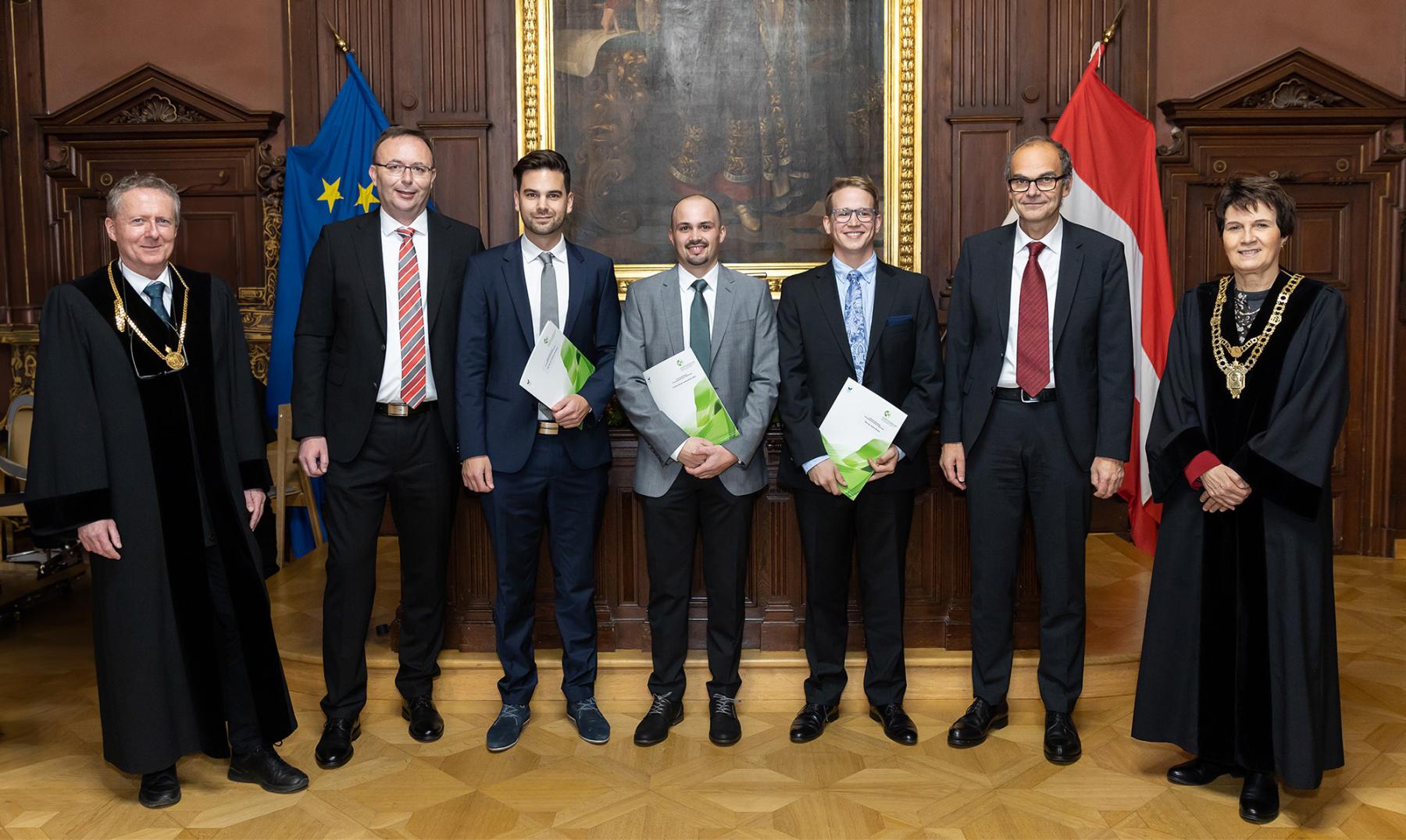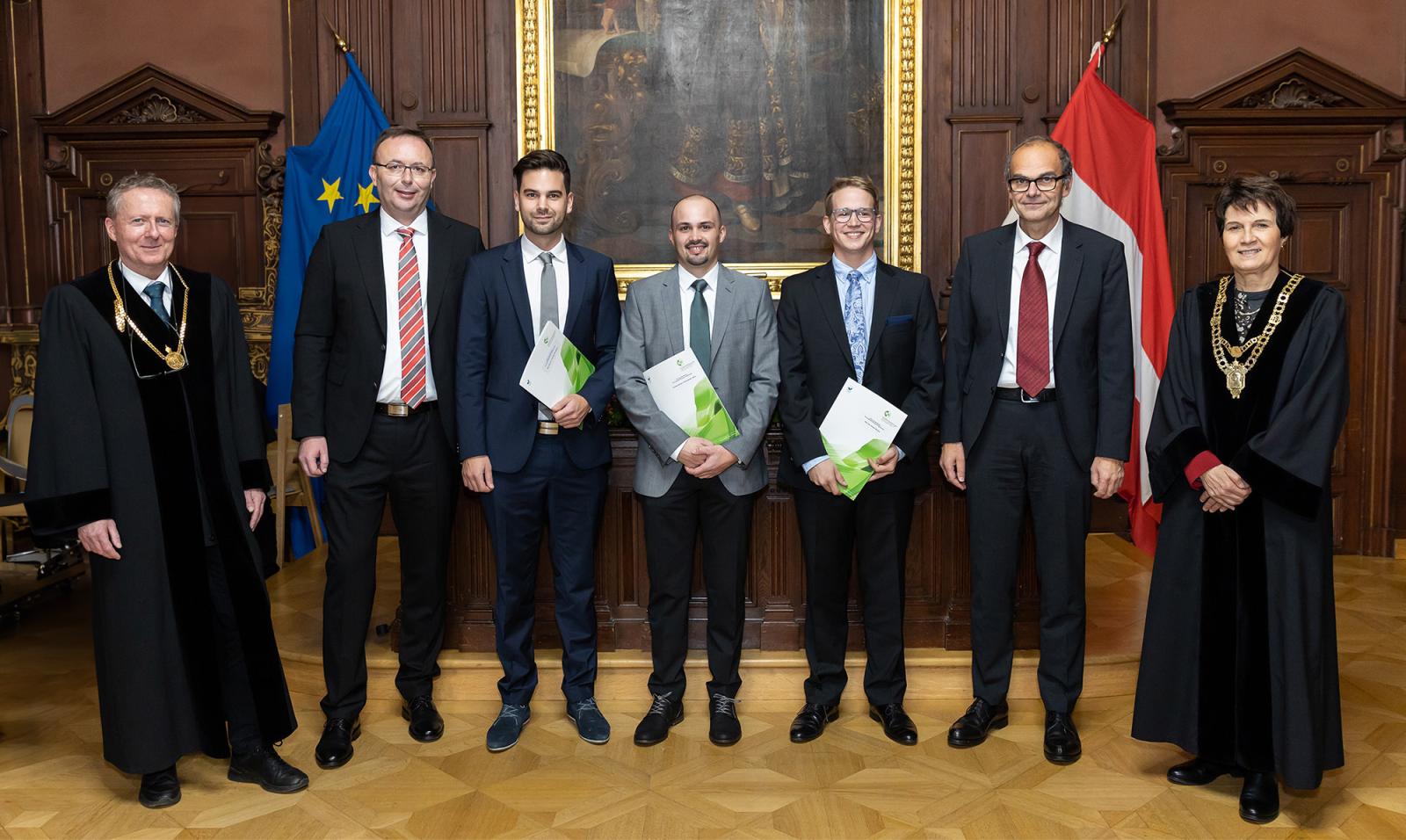On 24 November 2022 the VCE innovation prize was awarded within the framework of an academic ceremony in the festival room of Gregor-Mendel-Haus at the University of Natural Resources and Applied Life Sciences (BOKU). Outstanding engineering and scientific achievements as well as innovative technical contributions, which were written as diploma/master thesis, dissertation or habilitation treatise, are recognized by the VCE innovation prize. These papers of civil engineering comprise infrastructure, construction engineering, underground and structural engineering as well as monitoring, assessment and maintenance of structures.
„Das Bauwesen braucht innovative und nachhaltige Lösungen und Ansätze, um die komplexen ökologischen und ökonomischen Anforderungen des 21. Jahrhunderts zu bewältigen“, so DI Peter Furtner, Ingenieurkonsulent für Kulturtechnik und Wasserwirtschaft und Handlungsbevollmächtigter Gesellschafter bei VCE Vienna Consulting Engineers ZT GmbH. „Deswegen haben wir mit dem VCE Preis das zentrale Anliegen, wichtige Forschungsergebnisse in die Praxis zu bringen und damit die Innovationskraft im Bauwesen zu stärken.“
“Construction engineering needs innovative and sustainable solutions and approaches to be able to cope with the complex ecological and economic requirements of the 21st century”, said Peter Furtner, consulting engineer for hydraulic engineering and water management and authorized representative with VCE Vienna Consulting Engineers ZT GmbH. “Therefore, we have the central concern to bring important research results into practice and thus strengthen the innovative power in civil engineering with the VCE prize.”
The submitted contributions were assessed according to the criteria innovation, practice / science and relevance by an expert jury consisting of Univ.-Prof. Konrad Bergmeister from BOKU (Institute for Structural Engineering), Univ.-Prof. Nguyen Viet Tue from the Graz Technical University (Institute for Concrete Construction) and Peter Furtner of VCE.
The awarded papers deal with the improvement of the climate balance and the reaching of the climate targets in the fields of railway engineering, bridge construction and concrete construction.
Peter Furtner and Robert Schedler of VCE recognized the prize winners during the academic ceremony and handed over the prize money of € 5,000.
The winners are:
1st Place. Dr. Andreas Stollwitzer
Vienna University of Technology, Faculty for Civil Engineering
“Entwicklung eines Ansatzes zur rechnerischen Bestimmung der Dämpfung von Eisenbahnbrücken mit Schotteroberbau” (Developing an Approach for the Mathematical Calculation of the Damping Value of Railway Bridges with Ballasted Track) – Doctoral Thesis
In view of the global climate targets and traffic relocation towards rail traffic associated to this for reaching the latter currently the high-speed railway network is being globally extended. Railway bridges must be examined in advance with regard to their dynamic behaviour under high-speed traffic in order to identify occurring and potentially hazardous resonance events and to take measures for avoiding them.
2nd Place: Thomas Glanzer-Unterscheider, MSc.
Graz Technical University, Institute for Concrete Construction
“Schnittgrößenumlagerungen bei Rahmenbrücken” (Load Redistributions in Frame Bridges) – Master Thesis
There is an increasing trend in bridge construction towards integral construction as maintenance-intensive bearing structures can be avoided. A further benefit is the static system as, in contrast to the single-span girder, in the frame system with the same span lower internal forces and thus lower slenderness can be realized. In the paper the load-bearing behaviour of a frame bridge with different reinforcement ratios and soil consistencies was examined, analysed and compared with the conventional linear elastic calculations.
3rd Place: DI Florian Brosch
University of Natural Resources and Applied Life Sciences (BOKU) Vienna, Institute for Structural Engineering (IKI)
“Numerische Modellierung von Festbeton auf Basis experimenteller Untersuchungen und beispielhafte Anwendung an einem carbonbewehrten Betonträger” (Numerical Modeling of Hardened Concrete Based on Experimental Investigations and Exemplary Application on a Carbon-reinforced Concrete Beam) – Diploma Thesis
The carbon footprint of concrete components can be improved by optimizing the geometry and the choice of the material. It is essential to investigate the load-bearing behaviour of new mixture designs and new geometries to be able to evaluate their potential. Within the scope of this thesis the feasibility of calibrating numerical material models was investigated on the basis of experimentally determined material parameters.
On the photo (from left to right): Univ.Prof. Dr. Christian Obinger, vice chancellor for research and innovation at the University of Natural Resources and Applied Life Sciences; Peter Furtner VCE; Dr. Andreas Stollwitzer; Thomas Glanzer-Unterscheider, MSc.; Florian Brosch; Robert Schedler VCE; Univ.Prof. Dr. Eva Schulev-Steindl, LL.M., vice chancellor University of Natural Resources and Applied Life Sciences
Photo credit: Christoph Gruber - BOKU-IT

